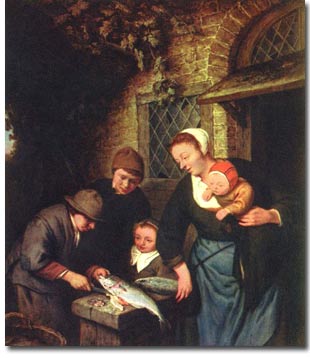 History of Holland
History of HollandHistory of Netherlands
Amsterdam Holland
Netherlands cities
Tulips of Holland
Dutch painters
Dutch portrait painters
Dutch genre painters
Adriaen van der Werff (1659-1722)
Adriaen van Ostade (1610-1685)<
Caspar Netscher (1639-1684)
Cornelis Troost (1697-1750)
Frans van Mieris (1635-1681)
Gabriel Metsu (1630-1667)
Gerard Dou (1613-1675)
Gerard Terborch (1617-1681)
Jan Steen (1626-1679)
Johannes Vermeer (1632-1675)
Nicolaas Maes (1632-1693)
Pieter de Hooch (1630-1677)
Dutch landscape painters
Dutch writers and scientists
Dutch paintings
Famous Dutch people
Dutch history
Dutch folk tales
Rembrandt and the Nightwatch
Holland history
Holland on sea history
Pictures of Holland
Dutch architecture
Holland facts
New Amsterdam history (New York)
Useful information
Adriaen van Ostade (1610-1685)
 Adriaen van Ostade lived from 1610 to 1685. Averse to his father's trade of linen-weaving, he became a fellow pupil with the Flemish Adriaan Brouwer in the Hals studio. Choosing the same kind of subjects as Brauwer, his treatment of these is less boisterous, more good-natured, sparkling, and with all its burlesque nature, less gross.
Adriaen van Ostade lived from 1610 to 1685. Averse to his father's trade of linen-weaving, he became a fellow pupil with the Flemish Adriaan Brouwer in the Hals studio. Choosing the same kind of subjects as Brauwer, his treatment of these is less boisterous, more good-natured, sparkling, and with all its burlesque nature, less gross.His scenes are taken from ordinary peasant life in cottages and humble dwellings, trivial subjects forsooth, but dealt with from a comic or grotesque point of view, which is distinctly amusing. His humourous mise-en-scene never presents overstrained action in the figures, but is a natural, artless portrayal of the life of the people about him.
He knew also how to juggle his paint with consummate skill in melting colours, deft application of light effect, and precision of handling. His pictures have technical freshness, a straightforwardness in means and intent, which makes the study of them most delightful. The influence of Rembrandt changed the work of his first period, which is more cool in tone, to a deeper, golden brown, while his third period, with greater finish, is less vigorous and less picturesque.
The large colour drawings which he made in his last period must be excepted. Many of these are in the Teyler museum in Haarlem, and are distinguished for breadth of treatment and harmony. His etchings also are of the best, his fine needle graving the most delicious prints.
He was twice married, the second time with a daughter of his townsman Jan van Goyen.

